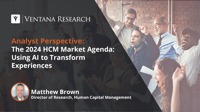The topic of skills is not new to the world of talent management or development, making many appearances in the talent conversation over the years. Recently, it has been a permanent fixture in the discussion, focusing on the total integration of skills across all aspects of the employee experience. The term “skills economy” describes the evolution of how value is assigned in the workplace and employment, emphasizing the importance of individual skills over traditional job credentials.
Read More
Topics:
Human Capital Management,
Learning Management,
Talent Management,
Workforce Management,
Payroll Management,
Total Compensation Management,
employee experience
I am happy to share insights gleaned from our latest Buyers Guide, an assessment of how well software providers’ offerings meet buyers’ requirements. The Ventana Research Workforce Management Suites Buyers Guide is the distillation of a year of market and product research by Ventana Research.
Read More
Topics:
Human Capital Management,
Workforce Management
Ventana Research recently announced its 2024 Market Agenda for Human Capital Management, continuing the guidance we have offered for two decades to help enterprises derive maximum potential from workforce- and people-related technology investments and initiatives. In crafting this Market Agenda, we focused on essential themes that are critical for HR organizations and for the software providers supporting them. The transformative nature of AI has not just begun to bring intelligence to HCM; it...
Read More
Topics:
Human Capital Management,
Learning Management,
Talent Management,
Workforce Management,
Payroll Management,
Total Compensation Management,
employee experience
Human resources has long been stereotyped as the department that relies on intuition and experience in decision-making. Enterprises have evolved to understand the importance of their workforce to achieving business outcomes and not just as a line item in the expense column of a balance sheet, earning HR executives a seat in Lin Manuel Miranda’s eponymous “room where it happens.” In doing so, those very executives must be armed with the data that ties worker performance to business outcomes;...
Read More
Topics:
Human Capital Management,
Workforce Management,
Total Compensation Management
In the realm of business process and workflow management, few names stand as tall as ServiceNow. After gaining traction for its cloud-based platform designed to help organizations manage and track IT service requests, the brand has grown into a behemoth, offering a wide range of services aimed at automating and optimizing business processes. Yet, in recent years, there’s been a notable and significant addition to the company's portfolio as it moved firmly into the realm of human capital...
Read More
Topics:
Human Capital Management,
Workforce Management,
employee experience
Workforce management software is used to automate and streamline core processes that organizations use to optimize their hourly workforce. These include capabilities like labor forecasting, scheduling, time tracking, absence management and compliance. In today’s competitive labor market with the complexities that accompany hyper-localized workforce rules and regulations, workforce management (WFM) software can play a key role in ensuring organizations have the right people in the right place at...
Read More
Topics:
Human Capital Management,
Workforce Management
Ventana Research recently announced its 2023 Market Agenda for Human Capital Management, continuing the guidance we’ve offered for two decades to help organizations derive maximum potential from workforce- and people-related technology investments and initiatives. In crafting this Market Agenda, we focused on three critical themes top-of-mind for both HCM vendors and buyers: Organizational resiliency, employee engagement and utilizing digital technology to derive deeper insights into the state...
Read More
Topics:
Human Capital Management,
Employee Engagement,
Learning Management,
Talent Management,
Workforce Management,
Payroll Management,
Total Compensation Management,
employee experience
People analytics enable organizations to gain data-driven insights that optimize the impact and value of the workforce. For decades, human capital management (HCM) leaders have been sold tools marketed as analytics that were no more than dashboards filled with nice visualizations of historic data with no context as to what each individual data point meant to their strategic objectives and initiatives. And yet, our recent Analytics and Data Benchmark Research shows that 83% of organizations...
Read More
Topics:
Human Capital Management,
Workforce Management,
Analytic Data Platforms
I am happy to share insights gleaned from our latest Value Index research, an assessment of how well vendors’ offerings meet buyers’ requirements. The Ventana Research Value Index: Workforce Management 2022 is the distillation of a year of market and product research by Ventana Research. Drawing on our Benchmark Research, we apply a structured methodology built on evaluation categories that reflect the real-world criteria incorporated in a request for proposal to workforce management vendors...
Read More
Topics:
Human Capital Management,
Learning Management,
Talent Management,
Workforce Management,
Payroll Management,
Total Compensation Management,
employee experience
Workforce management processes and activities, a major focus of investment and optimization efforts for decades, have undergone a huge transformation in recent years. In our view, this is mostly a function of two significant trends: the explosion of technology innovation associated with the use of artificial intelligence, machine learning and embedded analytics in many areas of a business including a range of human capital management processes and operations; and a major reframing of the...
Read More
Topics:
Human Capital Management,
Learning Management,
Talent Management,
Workforce Management,
Payroll Management,
Total Compensation Management,
employee experience


















